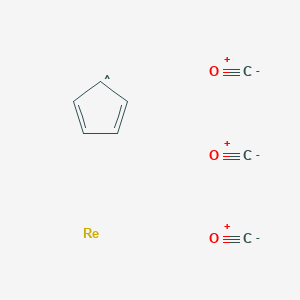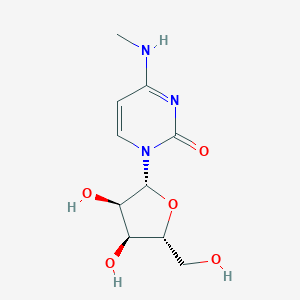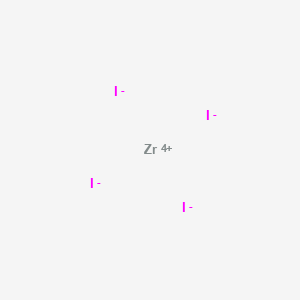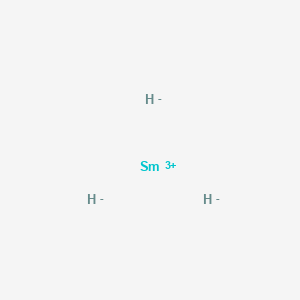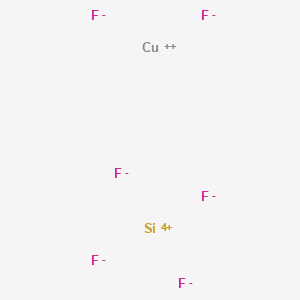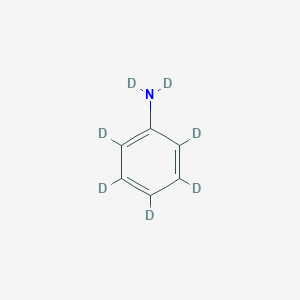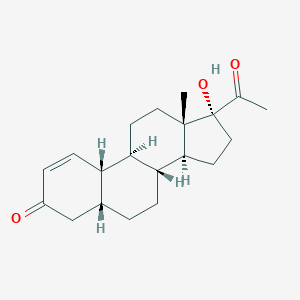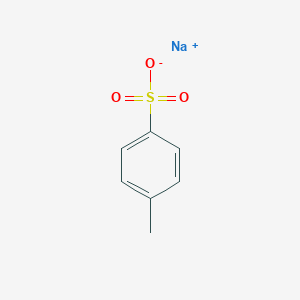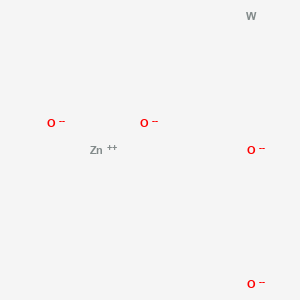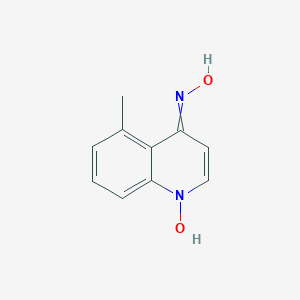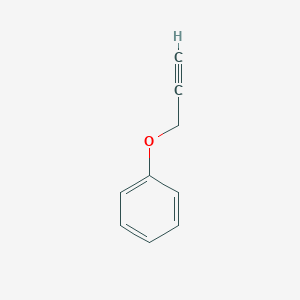
氯化钇(III)
- 点击 快速询问 获取最新报价。
- 提供有竞争力价格的高质量产品,您可以更专注于研究。
描述
Yttrium chloride is an inorganic compound composed of yttrium and chloride. It exists in two forms: the hydrate (YCl₃·6H₂O) and the anhydrous form (YCl₃). Both forms are colorless salts that are highly soluble in water and deliquescent . Yttrium chloride is used in various applications, including as a precursor for the synthesis of other yttrium compounds and in materials science.
科学研究应用
Yttrium chloride has a wide range of scientific research applications:
Chemistry: It is used as a precursor for the synthesis of yttrium-based materials, including phosphors and ceramics.
Medicine: Yttrium-based materials are used in medical lasers and biomedical implants.
作用机制
Target of Action
Yttrium(III) chloride, also known as Yttrium chloride(III), is an inorganic compound of yttrium and chloride . It is used as a precursor to synthesize yttrium-based nanomaterials such as yttrium aluminum garnet nanopowder and organometallic yttrium complexes . These materials find application in the field of catalysis, electroluminescent devices, and superconductors . Therefore, the primary targets of Yttrium(III) chloride are these yttrium-based nanomaterials and their associated applications.
Mode of Action
Yttrium(III) chloride reacts with potassium alkoxotitanates to form precursors for titanium-containing ceramics . It is also used in the production of yttrium alkyl alkoxide complexes . The compound interacts with its targets through chemical reactions, leading to the formation of new compounds with desired properties.
Biochemical Pathways
It is known to be involved in the synthesis of yttrium-based nanomaterials and organometallic yttrium complexes , which can have various downstream effects depending on their specific applications.
Pharmacokinetics
It has been documented that most of the yttrium administered was distributed into liver, bone, and spleen . Yttrium disappeared from the blood within 1 day but was retained in the organs for a long time . These findings suggest that Yttrium(III) chloride may have low bioavailability due to its rapid clearance from the blood and long retention in the organs.
Result of Action
The molecular and cellular effects of Yttrium(III) chloride’s action largely depend on its application. For instance, when used as a precursor to synthesize yttrium-based nanomaterials, the result of its action is the formation of these nanomaterials with desired properties .
Action Environment
The action, efficacy, and stability of Yttrium(III) chloride can be influenced by various environmental factors. For example, its solubility in water and other solvents can affect its availability for reactions . Moreover, its reactivity with other substances can be influenced by factors such as temperature and pH.
生化分析
Biochemical Properties
The biological effects of Yttrium refer to the activity, behavior, and toxicity of Yttrium element or compounds in cells, tissues, organs, and organisms . Yttrium is present in low abundance in soil, water bodies, and organisms . It is not an essential element for organisms and its bioavailability is very low .
Cellular Effects
Yttrium(III) chloride has been found to have acute hepatic injury and transient increase of plasma Ca following the injection . A significant and tremendous amount of Ca was deposited in the liver (over 10-fold) and spleen (over 100-fold), while Ca concentration was only slightly increased in the lung and kidney (less than 1.5-fold) . These results indicate that liver and spleen are primary target organs of intravenous-injected Yttrium(III) chloride .
Molecular Mechanism
Yttrium(III) chloride is taken up by phagocytic cells in the liver and spleen . Electron microscopic analyzes revealed that the colloidal yttrium-containing material was taken up by phagocytic cells in the liver and spleen .
Temporal Effects in Laboratory Settings
The elimination half-time of liver Y was 144 days at a dose of 1 mg Y/rat . Yttrium disappeared from the blood within 1 day but was retained in the organs for a long time .
Dosage Effects in Animal Models
The acute toxicity of Yttrium ion (Y3+), the deposition, retention, metabolism, and clearance have been documented in the previous reports . Hirano et al. studied time-course and dose-related changes in tissue distribution, subcellular localization, clearance, and acute toxicity of intravenous-injected Yttrium(III) chloride in rats .
Metabolic Pathways
Changes in Ca concentrations in liver, spleen, and lungs were in accordance with those of Yttrium(III) chloride . Two mechanisms of REE metabolism in the case of intravenous administration are suggested: (1) The REEs may be transported partly contained in serum protein and partly incorporated into phagocytes, and taken mostly into the reticuloendothelial system by the phagocytic mechanism and deposited there. (2) The major route of excretion of REEs may be biliary excretion and the REEs might be excreted gradually into feces .
Transport and Distribution
Yttrium(III) chloride is transported and distributed within cells and tissues . It is taken up by phagocytic cells in the liver and spleen .
Subcellular Localization
The subcellular localization of Yttrium(III) chloride is within the phagocytic cells in the liver and spleen . Electron microscopic analyzes revealed that the colloidal yttrium-containing material was taken up by phagocytic cells in the liver and spleen .
准备方法
Yttrium chloride is often prepared by the “ammonium chloride route,” starting from either yttrium oxide (Y₂O₃) or hydrated chloride or oxychloride . The synthetic route involves the following reactions:
From Y₂O₃: [ 10 \text{NH}_4\text{Cl} + \text{Y}_2\text{O}_3 \rightarrow 2 (\text{NH}_4)_2[\text{YCl}_5] + 6 \text{NH}_3 + 3 \text{H}_2\text{O} ]
From YCl₃·6H₂O: [ \text{YCl}_3·6\text{H}_2\text{O} + 2 \text{NH}_4\text{Cl} \rightarrow (\text{NH}_4)_2[\text{YCl}_5] + 6 \text{H}_2\text{O} ]
The pentachloride decomposes thermally to yield yttrium chloride(III): [ (\text{NH}_4)_2[\text{YCl}_5] \rightarrow 2 \text{NH}_4\text{Cl} + \text{YCl}_3 ]
化学反应分析
Yttrium chloride undergoes various types of chemical reactions, including:
Oxidation: Yttrium chloride can be oxidized to form yttrium oxychloride (YClO).
Reduction: It can be reduced to elemental yttrium using strong reducing agents.
Substitution: Yttrium chloride reacts with potassium alkoxotitanates to form precursors for titanium-containing ceramics.
Common reagents and conditions used in these reactions include ammonium chloride, potassium alkoxotitanates, and high temperatures. Major products formed from these reactions include yttrium oxychloride and yttrium alkyl alkoxide complexes.
相似化合物的比较
Yttrium chloride can be compared with other similar compounds, such as:
- Yttrium fluoride(III) (YF₃)
- Yttrium bromide(III) (YBr₃)
- Yttrium iodide(III) (YI₃)
- Scandium chloride(III) (ScCl₃)
- Lutetium chloride(III) (LuCl₃)
Yttrium chloride is unique due to its high solubility in water and its ability to form various yttrium-based materials. Its layered crystal structure, shared by compounds like aluminum chloride (AlCl₃), also contributes to its distinct properties .
属性
CAS 编号 |
10361-92-9 |
|---|---|
分子式 |
Cl3Y |
分子量 |
195.26 g/mol |
IUPAC 名称 |
trichloroyttrium |
InChI |
InChI=1S/3ClH.Y/h3*1H;/q;;;+3/p-3 |
InChI 键 |
PCMOZDDGXKIOLL-UHFFFAOYSA-K |
SMILES |
[Cl-].[Cl-].[Cl-].[Y+3] |
规范 SMILES |
Cl[Y](Cl)Cl |
| 10361-92-9 | |
物理描述 |
WetSolid |
相关CAS编号 |
10025-94-2 (hexahydrate) |
同义词 |
YCl3 yttrium chloride yttrium chloride hexahydrate yttrium chloride, (88)Y-labeled yttrium chloride, (90)Y-labeled yttrium chloride, (91)Y-labeled |
产品来源 |
United States |
体外研究产品的免责声明和信息
请注意,BenchChem 上展示的所有文章和产品信息仅供信息参考。 BenchChem 上可购买的产品专为体外研究设计,这些研究在生物体外进行。体外研究,源自拉丁语 "in glass",涉及在受控实验室环境中使用细胞或组织进行的实验。重要的是要注意,这些产品没有被归类为药物或药品,他们没有得到 FDA 的批准,用于预防、治疗或治愈任何医疗状况、疾病或疾病。我们必须强调,将这些产品以任何形式引入人类或动物的身体都是法律严格禁止的。遵守这些指南对确保研究和实验的法律和道德标准的符合性至关重要。


